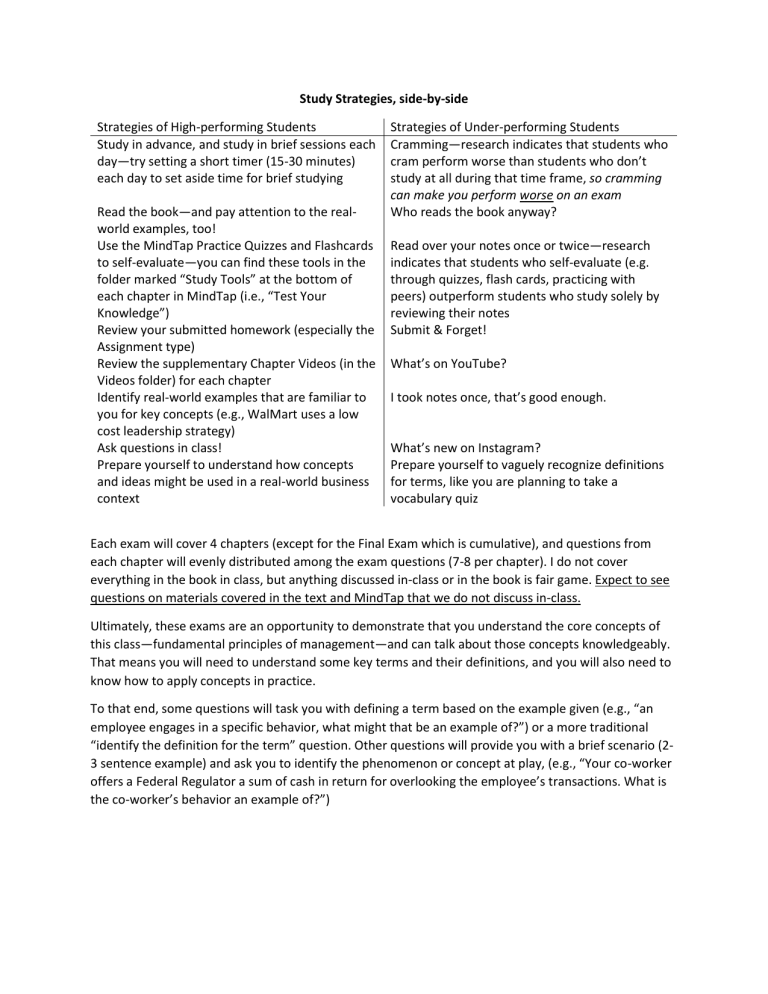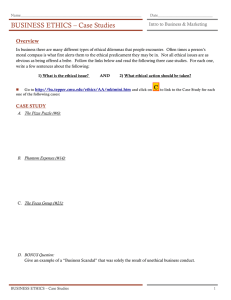
Study Strategies, side-by-side Strategies of High-performing Students Study in advance, and study in brief sessions each day—try setting a short timer (15-30 minutes) each day to set aside time for brief studying Read the book—and pay attention to the realworld examples, too! Use the MindTap Practice Quizzes and Flashcards to self-evaluate—you can find these tools in the folder marked “Study Tools” at the bottom of each chapter in MindTap (i.e., “Test Your Knowledge”) Review your submitted homework (especially the Assignment type) Review the supplementary Chapter Videos (in the Videos folder) for each chapter Identify real-world examples that are familiar to you for key concepts (e.g., WalMart uses a low cost leadership strategy) Ask questions in class! Prepare yourself to understand how concepts and ideas might be used in a real-world business context Strategies of Under-performing Students Cramming—research indicates that students who cram perform worse than students who don’t study at all during that time frame, so cramming can make you perform worse on an exam Who reads the book anyway? Read over your notes once or twice—research indicates that students who self-evaluate (e.g. through quizzes, flash cards, practicing with peers) outperform students who study solely by reviewing their notes Submit & Forget! What’s on YouTube? I took notes once, that’s good enough. What’s new on Instagram? Prepare yourself to vaguely recognize definitions for terms, like you are planning to take a vocabulary quiz Each exam will cover 4 chapters (except for the Final Exam which is cumulative), and questions from each chapter will evenly distributed among the exam questions (7-8 per chapter). I do not cover everything in the book in class, but anything discussed in-class or in the book is fair game. Expect to see questions on materials covered in the text and MindTap that we do not discuss in-class. Ultimately, these exams are an opportunity to demonstrate that you understand the core concepts of this class—fundamental principles of management—and can talk about those concepts knowledgeably. That means you will need to understand some key terms and their definitions, and you will also need to know how to apply concepts in practice. To that end, some questions will task you with defining a term based on the example given (e.g., “an employee engages in a specific behavior, what might that be an example of?”) or a more traditional “identify the definition for the term” question. Other questions will provide you with a brief scenario (23 sentence example) and ask you to identify the phenomenon or concept at play, (e.g., “Your co-worker offers a Federal Regulator a sum of cash in return for overlooking the employee’s transactions. What is the co-worker’s behavior an example of?”) Specific Notes for Exam 1 The following information is not exhaustive. There will be items on the exam that are not listed as part of this brief overview of the core concepts of each chapter. The information presented here is merely intended to act as a starting point for studying for the exam. You will need to be competent with all of the material in the textbook Chapters 1-4 and discussed in class pertaining to those chapters to do well on the exam. Chapter 1: Introduction • • • • • • • VUCA Managing v. Leading Leadership Skills o Conceptual skills o Interpersonal skills o Technical skills o Which level of leadership uses each skill the most? Historical Perspectives of Business o Bureaucratic organizational structure Theories of management o Scientific management o Human Relations Movement o Contingency Perspective Perspectives on the Purpose of Business o Managerial view o Shareholder view o Stakeholder view Predicting the future o Contingency planning o Trend analysis o Contextual intelligence Chapter 2: The Environment • • • • Globalization Regional Trade Agreements o Theory of comparative advantage The Layers of the Environment o Global Environment o General environment o Task environment o Internal environment General Environment o Political dimension o Legal dimension o Economic dimension o • • Sociocultural dimension ▪ Values and norms ▪ Universal social dimensions o Technological dimension Task Environment o Competitors o Customers o Suppliers Internal environment o Employees o Owners/founders o Board of Directors o Culture Chapter 3: Ethics and Corporate Responsibility • • • • Ethical Frameworks o Utilitarian ethics o Kantian ethics o Virtue ethics Justice o Distributive justice o Procedural justice Moral Dilemmas and Ethical Challenges o Environmental dilemmas o Privacy dilemmas o Conflicts of interest o Trade secrets o Bribery o Whistle-blowing Corporate Social Responsibility o Ethical versus legal o Using CSR as a business strategy o CSR’s effectiveness Chapter 4: Intro to Strategy • • • Historical Roots of Strategy o Rules of engagement o Conglomeration o Complexity o Corporate planning Analyzing the Environment o Core competencies Formulating Strategy o Strategic activities • • • • ▪ Managing trade-offs ▪ Choosing a set of activities ▪ Creating fit o Vision o Mission o objective Competitive Advantage Business-level Strategy Versus Corporate-level Strategy o Common mistake for students! Strategies for Going Global o Multinational o Global o International o Transnational ▪ Common mistake for students! Market entry strategies o Exporting o Licensing o Franchising o Joint ventures o Alliance o Wholly owned subsidiary Key Questions/Tasks 1. 2. 3. 4. 5. 6. 7. 8. 9. 10. 11. 12. 13. 14. 15. 16. 17. 18. 19. 20. 21. What contributes to uncertainty (i.e. the VUCA environment)? Distinguish between the theories of management (i.e. scientific management). Distinguish between the perspectives of business (i.e. contingency theory). Identify the major classes/categories of leadership skills and which levels of management use them the most (i.e. conceptual skills). What contributed to globalization? How/why do regional trade agreements work? What contributed to the development of corporate planning? What are the various layers of an organization’s environment? What are the respective components/dimensions of each layer of an organization’s environment? How do the components/dimensions of the environment affect an organization? Distinguish between the various ethical frameworks (i.e. Kantianism). Identify how each ethical framework would respond to an ethical challenge/issue. Distinguish between procedural and distributive justice. Identify and distinguish the various ethical challenges in action (i.e. bribery). Identify the components of an effective Corporate Social Responsibility program. How can an organization use a Corporate Social Responsibility program effectively? How is strategy formulated? What are the major considerations/components of formulating a strategy (i.e. managing tradeoffs)? What are mission statements and visions, and how do they relate to strategy? Identify and distinguish between the strategies for going global (i.e. transnational strategy). Identify and distinguish between the market entry strategies (i.e. joint venture)

